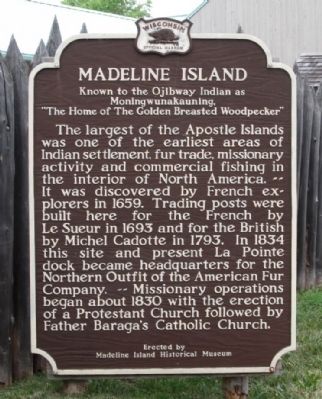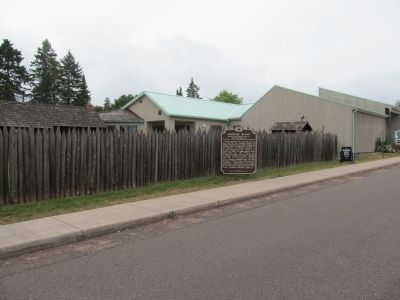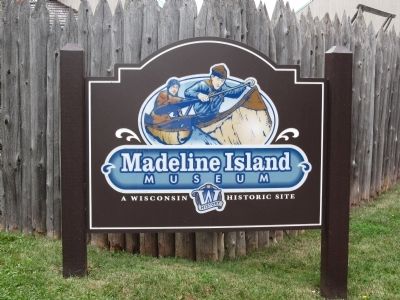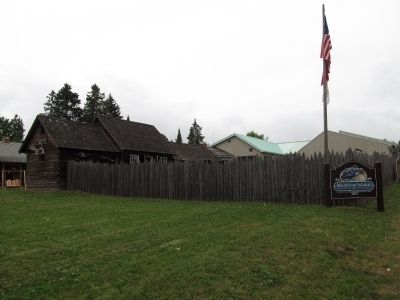La Pointe in Ashland County, Wisconsin — The American Midwest (Great Lakes)
Madeline Island
Known to the Ojibway Indians as Moningwunakauning, "The Home of The Golden Breasted Woodpecker"
Erected 1961 by Madeline Island Historical Museum. (Marker Number 108.)
Topics and series. This historical marker is listed in these topic lists: Exploration • Industry & Commerce • Native Americans • Settlements & Settlers. In addition, it is included in the Wisconsin Historical Society series list. A significant historical year for this entry is 1659.
Location. Marker has been reported permanently removed. It was located near 46° 46.814′ N, 90° 47.297′ W. Marker was in La Pointe, Wisconsin, in Ashland County. Marker was at the intersection of Bayfield - La Pointe Avenue and Colonel Woods Avenue (County Route H), on the left when traveling north on Bayfield - La Pointe Avenue. This marker has been replaced by Mooningwaanikaaning Wisconsin State Historical Marker (https://www.hmdb.org/m.asp?m=234361). Touch for map. Marker was at or near this postal address: 226 Colonel Woods Ave, La Pointe WI 54850, United States of America.
We have been informed that this sign or monument is no longer there and will not be replaced. This page is an archival view of what was.
Other nearby markers. At least 8 other markers are within 3 miles of this location, measured as the crow flies. Mooningwaanikaaning (here, next to this marker); Early Vessels (approx. 0.4 miles away); La Pointe Indian Cemetery (approx. 0.6 miles away); Michel Cadotte (approx. 1.8 miles away); A Turning Point in Place and Time (approx. 2.3 miles away); Schooner Pretoria (approx. 2.3 miles away); Memorial to Commercial Fishermen of Bayfield (approx. 2˝ miles away); The Booth Cooperage (approx. 2˝ miles away). Touch for a list and map of all markers in La Pointe.
Also see . . .
1. Madeline island History. (Submitted on July 20, 2012, by Paul Fehrenbach of Germantown, Wisconsin.)
2. Madeline Island Museum. (Submitted on July 20, 2012, by Paul Fehrenbach of Germantown, Wisconsin.)
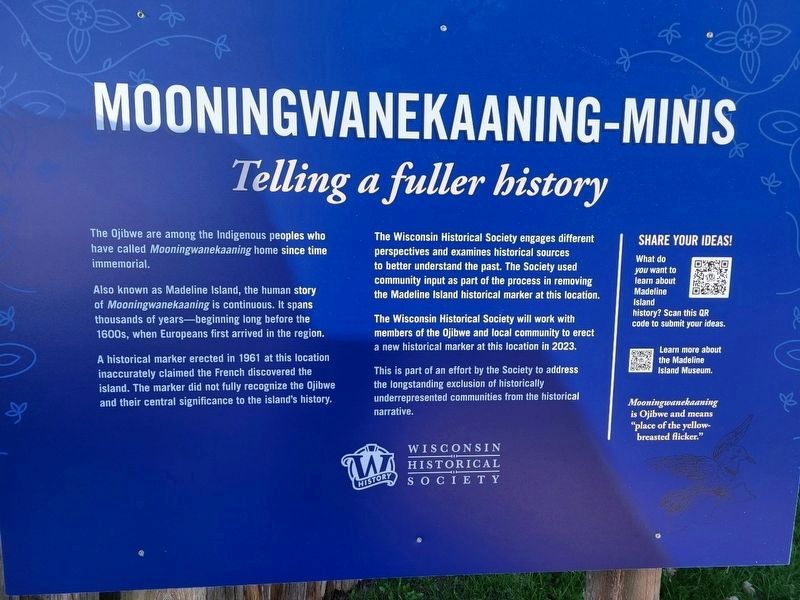
Photographed By Fitzie Heimdahl
2. An additional Madeline Island Marker
Mooningwanekaaning-minis
Telling a fuller history
The Ojibwe are among the Indigenous peoples who have called Mooningwanekaaning home since time immemorial. Also known as Madeline Island, the human story of Mooningwanekaaning is continuous. It spans thousands of years-beginning long before the 1600s, when Europeans first arrived in the region. A historical marker erected in 1961 at this location inaccurately claimed the French discovered the island. The marker did not fully recognize the Ojibwe and their central significance to the island's history.
The Wisconsin Historical Society engages different perspectives and examines historical sources to better understand the past. The Society used community input as part of the process in removing the Madeline Island historical marker at this location. The Wisconsin Historical Society will work with members of the Ojibwe and local community to erect a new historical marker at this location in 2023. This is part of an effort by the Society to address the longstanding exclusion of historically underrepresented communities from the historical narrative.
Telling a fuller history
The Ojibwe are among the Indigenous peoples who have called Mooningwanekaaning home since time immemorial. Also known as Madeline Island, the human story of Mooningwanekaaning is continuous. It spans thousands of years-beginning long before the 1600s, when Europeans first arrived in the region. A historical marker erected in 1961 at this location inaccurately claimed the French discovered the island. The marker did not fully recognize the Ojibwe and their central significance to the island's history.
The Wisconsin Historical Society engages different perspectives and examines historical sources to better understand the past. The Society used community input as part of the process in removing the Madeline Island historical marker at this location. The Wisconsin Historical Society will work with members of the Ojibwe and local community to erect a new historical marker at this location in 2023. This is part of an effort by the Society to address the longstanding exclusion of historically underrepresented communities from the historical narrative.
Credits. This page was last revised on November 2, 2023. It was originally submitted on July 20, 2012, by Paul Fehrenbach of Germantown, Wisconsin. This page has been viewed 1,468 times since then and 66 times this year. Last updated on October 16, 2023, by Fitzie Heimdahl of Eau Claire, Wisconsin. Photos: 1. submitted on July 20, 2012, by Paul Fehrenbach of Germantown, Wisconsin. 2. submitted on May 26, 2022, by Fitzie Heimdahl of Eau Claire, Wisconsin. 3, 4, 5. submitted on July 20, 2012, by Paul Fehrenbach of Germantown, Wisconsin. • J. Makali Bruton was the editor who published this page.
